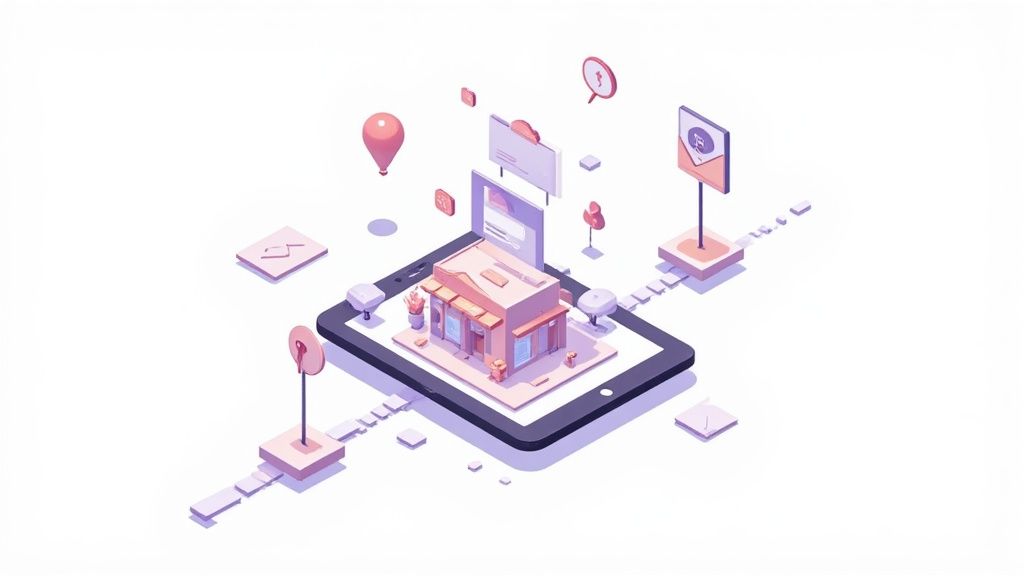Diving into digital marketing can feel like you've been dropped into a foreign country. Suddenly, you're surrounded by acronyms and strategies that sound completely alien. But don't let that intimidate you.
At its core, digital marketing for beginners is just about meeting your customers where they already are: online. It's the modern-day equivalent of putting up a billboard, handing out flyers, or building a great reputation in your local community—just with a much bigger reach.
Your Digital Marketing Journey Starts Here
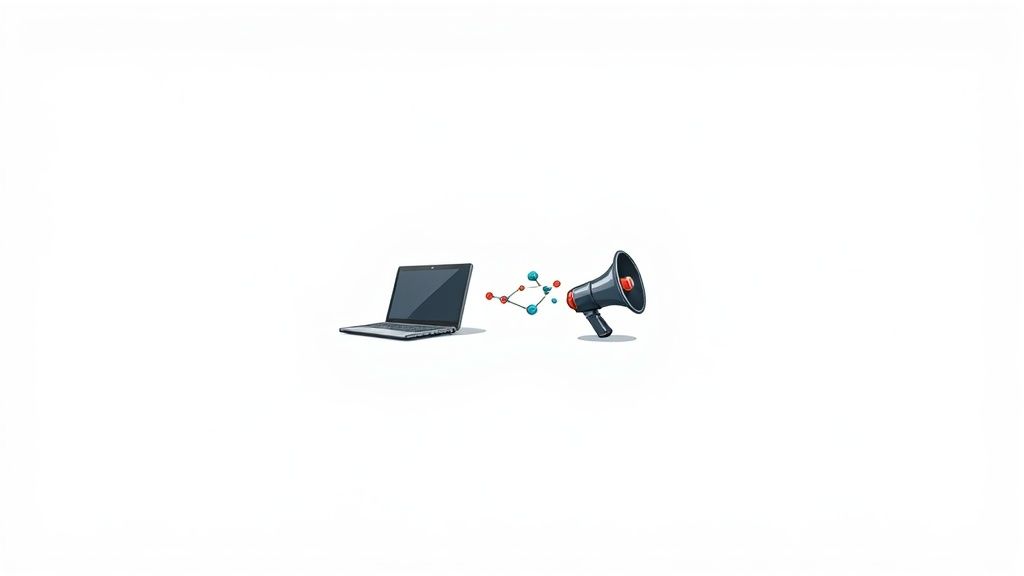
Imagine your business is a fantastic little shop tucked away on a quiet side street. Without any signs or promotion, nobody would ever know to stop by. Digital marketing is your toolkit for putting up those signs, creating buzz, and guiding people straight to your digital doorstep. It's an incredibly powerful way for businesses of any size to get noticed and grow.
And this isn't some niche field; it's central to how business is done today. The global digital marketing market hit an eye-watering USD 598.58 billion in 2024. That number tells a clear story: if you're not marketing online, you're missing out on a massive opportunity.
Why Digital Marketing Matters
What really sets digital apart from old-school marketing is its precision. Forget casting a wide, expensive net and just hoping for the best. Here, you can target exactly who you want to reach, see what's working in real-time, and make adjustments based on actual data, not just guesswork.
The best digital marketers know exactly how each email, post, and ad contributes to their bigger goals. When you grasp the fundamentals, every single action you take has a clear purpose.
And you don't need a huge budget or a marketing department to get started. All you really need is a solid grasp of the basics and a willingness to learn as you go. We're going to break down the key pieces of the puzzle:
- Search Engine Optimization (SEO): This is all about making it dead simple for people to find you on Google when they're searching for what you offer.
- Content Marketing: Think of this as creating genuinely useful articles, videos, or guides that attract your ideal customers by helping them solve a problem.
- Social Media Marketing: It's about more than just posting updates. It's about building a community and having real conversations on platforms like Instagram and Facebook.
- Email Marketing: This lets you talk directly to people who are already interested, building relationships and turning casual interest into loyalty.
Each of these elements works together, creating a strong, cohesive online presence. If you're running a small business and just starting to piece this all together, this complete guide to digital marketing for small businesses is a fantastic next step. Your journey begins with understanding these core ideas, which we'll unpack one by one.
Understanding Core Digital Marketing Channels
To really get the hang of digital marketing, you have to know the main roads on the digital highway. These “channels” are just the different paths you can take to reach your audience, and each one has a specific job. Think of it like a toolbox: you wouldn't use a hammer to turn a screw, and you definitely wouldn't use every marketing channel for the same goal.
The real magic happens when you get these channels to work together. It’s not about shouting from every rooftop at once, but about showing up in the right places at the right times. Let’s break down the five fundamental channels you absolutely need to know.
Search Engine Optimization (SEO): Your Digital Storefront Sign
Search Engine Optimization, or SEO, is all about making your website more attractive to search engines like Google. The whole point is to show up as high as possible in the search results when someone is looking for what you offer. Simply put, it's like making sure your shop has a huge, clear sign and is listed correctly on every map so people can actually find you.
A solid SEO strategy brings in a steady flow of organic traffic—that means visitors who find you naturally, without you having to pay for an ad. This is a long-game strategy that builds serious credibility and trust over time. Since over 68% of all online experiences kick off with a search engine, SEO isn't just nice to have; it's non-negotiable.
Pay-Per-Click (PPC) Advertising: The Highway Billboard
If SEO is the slow and steady marathon, Pay-Per-Click (PPC) advertising is the sprint. With PPC, you pay a small fee every single time someone clicks on your ad. The most common flavor of this is search engine advertising, where your ad appears right at the top of Google’s search results for specific keywords.
Think of it as renting a massive billboard on the busiest digital highway imaginable. It grabs immediate attention from people who are actively searching for a solution you provide. This channel is fantastic for driving traffic quickly, testing out new offers, and zeroing in on very specific groups of people. As you get more comfortable, you can explore guides on specific channels like Paid Search (PPC) to really understand how they can drive instant results.
The real power of digital marketing lies in how these different channels support one another. A great blog post (Content Marketing) can be promoted through an email (Email Marketing) and a paid ad (PPC), all while boosting your website’s authority (SEO).
This simple hierarchy shows how different levels of goals connect, from broad business objectives down to specific campaign actions.
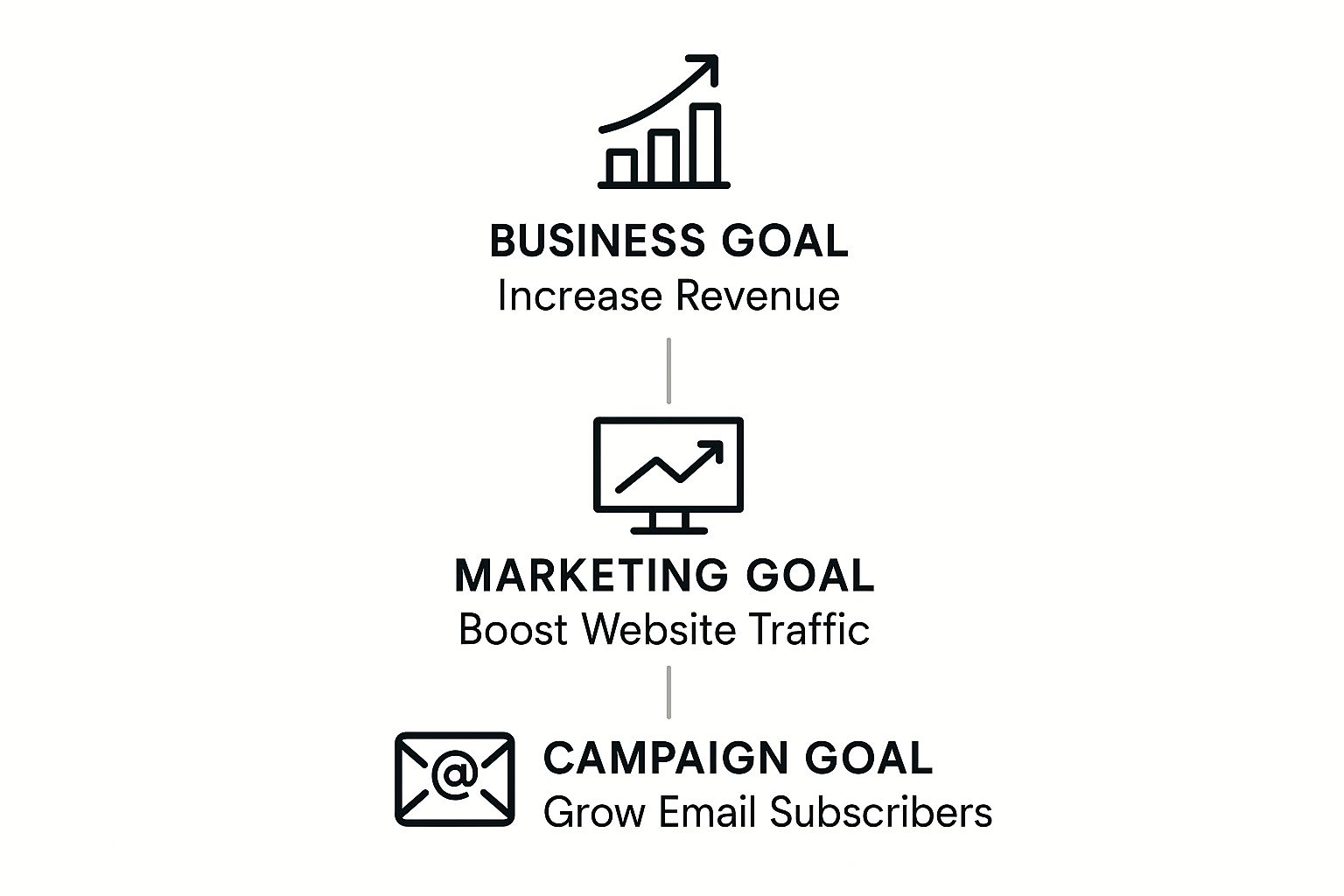
As the visual shows, a campaign goal like growing subscribers directly supports the marketing goal of boosting traffic, which ultimately contributes to the main business goal of increasing revenue.
Content Marketing: The Helpful Expert
Content marketing is the art of creating and sharing stuff that’s genuinely valuable and relevant to attract and keep an audience. This isn't about a hard sell. It’s about positioning yourself as the go-to expert who’s always there to help. This content can be anything from:
- Blog Posts: Answering the common questions your audience is typing into Google.
- Videos: Showing your product in action or offering helpful tutorials.
- Ebooks and Guides: Giving away in-depth information in exchange for an email address.
- Infographics: Making complex data look simple and easy to understand.
By giving away real value, you build trust and a loyal following. Then, when they’re finally ready to buy, your brand is the first one they’ll think of. It’s the fuel that powers almost every other marketing channel.
Social Media Marketing: The Community Hub
Social Media Marketing (SMM) is about using platforms like Facebook, Instagram, LinkedIn, and X to connect with your audience, build up your brand, and send people to your website. Every platform has its own vibe and audience, so the trick is to figure out where your customers are actually hanging out.
It’s about so much more than just posting updates; it's about building a real community. You can use social media to:
- Engage in Conversations: Actually reply to comments and messages to show you're a real person who's listening.
- Share Your Content: Push your latest blog posts and videos out to a much wider audience.
- Run Targeted Ads: Reach incredibly specific groups of people with your promotions.
Think of social media as your local town square—it’s the place to interact, listen, and build genuine relationships.
Email Marketing: The Direct Conversation
Email marketing is still one of the most powerful and direct ways to talk to your audience. It lets you send tailored messages straight to people who have already raised their hand and said they're interested by joining your list. It’s like having a one-on-one conversation with a customer who just walked into your store.
Unlike social media, where mysterious algorithms decide who sees your posts, an email goes right into their inbox. This channel is perfect for guiding potential customers, announcing special offers, and turning one-time buyers into lifelong fans. For every $1 spent, email marketing generates an average of $36 in ROI, making it an insanely efficient tool, especially when you're just starting out.
Key Digital Marketing Channels at a Glance
To help you keep these channels straight, here's a quick cheat sheet. It breaks down what each channel is for and how beginners can get the most out of it.
| Channel | Primary Goal | Best For Beginners To… |
|---|---|---|
| SEO | Drive long-term, organic traffic and build authority. | Answer common customer questions with helpful blog content. |
| PPC | Generate immediate traffic and test offers quickly. | Run small, targeted ad campaigns for a specific product or service. |
| Content Marketing | Build trust and establish expertise. | Create one high-quality guide or a few blog posts on a core topic. |
| Social Media | Build community and engage with the audience. | Pick one platform where their audience is most active and post consistently. |
| Email Marketing | Nurture leads and drive repeat business. | Start building an email list by offering a simple freebie, like a checklist. |
This table isn't meant to be exhaustive, but it gives you a solid starting point for deciding where to focus your initial energy. As you grow, you'll find that the best strategies often blend two or three of these channels together.
Building Your First Digital Marketing Strategy
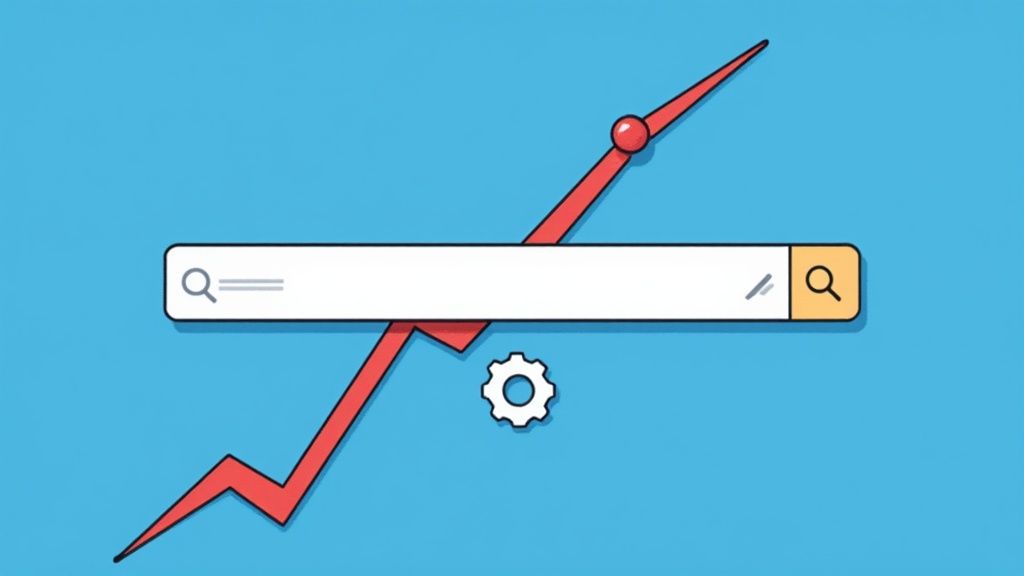
Knowing the different marketing channels is one thing, but making them all work together is a whole other ballgame. That's where a strategy comes in. It’s your game plan, turning abstract ideas into focused, deliberate action. Without one, you’re basically just throwing content at the wall and hoping something sticks.
Think of it like building a house. You wouldn't just start laying bricks without a blueprint. A digital marketing strategy is that blueprint. It makes sure every blog post, every ad, and every email contributes to building something strong and cohesive. And it all starts with one question: Who are you talking to?
Define Your Ideal Customer
Before you can sell a single thing, you have to know who you're selling to. This is all about creating a buyer persona—a detailed, almost-real profile of your perfect customer. It's built from market research and real data you have on the people who already buy from you.
This goes way beyond basic demographics like age or city. A truly useful persona gets into their motivations, their goals, and the problems that keep them up at night.
Creating a detailed buyer persona is the difference between shouting into a void and having a meaningful conversation. It ensures your message lands because it's designed for a specific person, not a generic crowd.
Let’s imagine a local bakery trying to get more online cake orders.
- Bad Customer Profile: "Women aged 25-45 who live nearby." This is so broad it's useless. It tells you nothing about their needs.
- Good Buyer Persona (Let's call her "Celebration Sarah"):
- Age: 32
- Job: Juggles a busy office job.
- Goals: Wants to make birthdays and special events feel memorable without adding more stress to her packed schedule.
- Pain Points: She's short on time, worries about the quality of generic store-bought cakes, and finds most custom ordering websites clunky and confusing.
- Online Habits: She's scrolling Instagram for party ideas and Googling "best local bakeries" on her phone.
Suddenly, the bakery knows exactly who they’re marketing to. They can create Instagram posts that show how easy their online ordering is. They can showcase stunning, stress-free celebration cakes. Knowing "Sarah" makes every other decision a heck of a lot clearer.
Set SMART Marketing Goals
Once you know your audience, you have to decide what you actually want to achieve. Fuzzy goals like "get more customers" don't work because you can't measure them. This is where the SMART goal framework is a lifesaver.
Your goals need to be:
- Specific: State exactly what you want to accomplish. No vague wishes.
- Measurable: Define how you'll track progress with real numbers.
- Achievable: Set a goal you can realistically hit.
- Relevant: Make sure the goal actually supports your bigger business objectives.
- Time-bound: Give yourself a deadline to create focus and a little bit of urgency.
For our bakery targeting "Celebration Sarah," a SMART goal might sound like this: "Increase online cake orders by 20% over the next three months by promoting our new online ordering system on Instagram and through local SEO."
This goal is specific (20% increase in online cake orders), measurable (they can track it in their e-commerce system), achievable (20% is a stretch but not impossible), relevant (it drives direct revenue), and time-bound (three months).
Choose the Right Channels
Okay, so you know who you’re targeting and what you want to achieve. Now you can pick your channels. The biggest mistake beginners make is trying to be everywhere at once. Don't do it. Focus your energy where your ideal customer actually hangs out online.
Since "Celebration Sarah" uses Instagram for inspiration and Google for research, the bakery should zero in on:
- Social Media Marketing: Run targeted ads on Instagram showing off their most beautiful cakes. The visuals are everything here. To get that irresistible, professional look without a big photo shoot, they could even use an AI product photo generator to make their phone pictures look like they came from a studio.
- Search Engine Optimization (SEO): Optimize their website for keywords like "custom birthday cakes near me." This is how they'll catch Sarah at the exact moment she's ready to buy.
By sticking to just these two channels, the bakery can concentrate its effort and budget for maximum impact instead of spreading itself too thin. It’s also about personalizing the experience on those channels. It's no surprise that over 56% of marketing leaders are investing heavily in personalization—when you make customers feel like you're speaking directly to them, they listen.
Essential Tools and Metrics for Beginners
So, you've got a strategy in motion. Now what? How do you actually know if any of it is working? Digital marketing isn't about throwing things at the wall and hoping they stick; it's about measuring what happens next. The good news is you don't need a huge, expensive tech stack to figure this out.
Think of it like flying a plane for the first time. The tools are your dashboard—your altitude, speed, and heading indicators. The metrics are the readings on those gauges. Without them, you’re just flying blind and hoping you don't run out of fuel.
Let's look at the essential, beginner-friendly tools and numbers that will get you off the ground without sending you into a tailspin.
Your Starter Toolkit
You can get an incredible amount done with tools that are either free or very affordable. The goal isn’t to become a master of a dozen different platforms. Instead, focus on getting comfortable with a few key players that cover the absolute essentials.
To help you get started, here are a few of the best tools for different marketing jobs.
Essential Beginner Marketing Tools
| Tool Category | Recommended Tool | Primary Use Case |
|---|---|---|
| Website Analytics | Google Analytics | Understanding who visits your site, how they got there, and what they do. |
| Social Media Graphics | Canva | Creating professional-looking social posts, ads, and graphics with zero design skill. |
| Email Marketing | Mailchimp | Building an email list and sending newsletters to your audience. |
| SEO Basics | Ubersuggest | Finding keywords your customers are searching for and analyzing competitor sites. |
These platforms give you a solid foundation. They provide the core functions you need to launch your first campaigns and, more importantly, see what's actually happening.
Key Metrics That Actually Matter
Data can feel like a tidal wave. The secret is to ignore most of it and laser-focus on a handful of Key Performance Indicators (KPIs) that tell you the most important parts of the story. You want numbers that connect directly back to your business goals.
"If you can't measure it, you can't improve it." This old business mantra is the absolute heart of digital marketing. The right metrics don’t just report on the past; they give you a clear roadmap for what to do next.
When you log into a tool like Google Analytics, you’ll see a dashboard that gives you a quick snapshot of what's going on.
This view instantly gives you clues about your audience, where they're coming from, and which pages they care about. It's the starting point for understanding their behavior.
So, what should you really be looking at? Experienced marketers obsess over metrics like return on investment (ROI), conversion rates, and customer acquisition cost (CAC) because these numbers prove whether their efforts are making money. You can learn more about how pros use these statistics to drive their digital marketing strategies.
Here are the top five metrics every beginner should get comfortable with:
1. Traffic
This is the simplest one: how many people are visiting your website? More importantly, where are they coming from? Google Analytics will show you if your visitors are finding you through Google search, social media, or links from other websites. This tells you which channels are your heavy hitters.
2. Conversion Rate
This is arguably the most important metric of all. A "conversion" is any key action you want a visitor to take—making a purchase, signing up for your email list, or filling out a contact form. Your conversion rate is the percentage of visitors who actually do that thing. A higher rate means you're doing a great job turning browsers into customers.
3. Click-Through Rate (CTR)
This applies anytime you put a link in front of someone—in an ad, an email, or a Google search result. CTR is the percentage of people who saw your link and were compelled enough to click it. A high CTR is a strong signal that your headline, ad copy, or offer is hitting the mark.
4. Engagement Rate
This is a core metric for social media. It bundles up all the interactions (likes, comments, shares, saves) and measures them against your total followers or the number of people who saw your post. High engagement means your content is resonating, not just being passively scrolled past.
5. Customer Acquisition Cost (CAC)
This one is a little more advanced, but it's critical for understanding your profitability. CAC is simply the total cost of your marketing efforts divided by the number of new customers you gained from it. For example, if you spent $500 on ads and got 10 new customers, your CAC is $50. A low CAC is the hallmark of efficient, effective marketing. Using a quality Shopify photo editor to create stunning visuals can make your ads more effective, which directly helps lower your CAC.
Common Beginner Mistakes to Avoid
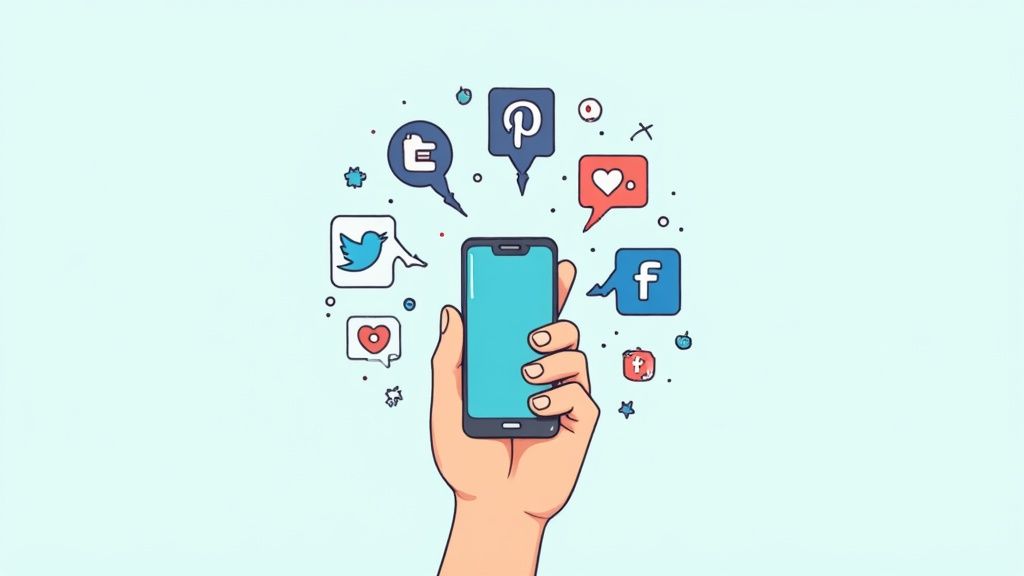
Diving into digital marketing is exciting, but it’s really easy to stumble. One of the fastest ways to get ahead is to learn from the missteps of others. Think of it as getting a map of all the potholes before you even start the car.
By understanding these common traps, you can build good habits right from the start. This turns potential headaches into learning moments, giving you the confidence you need for the road ahead.
Ignoring Search Engine Optimization
One of the most common mistakes is treating SEO as an afterthought. It happens all the time: someone builds a beautiful website but completely ignores the basic rules that help search engines find and rank it.
Without SEO, your website is like a gorgeous new store with no sign on the door. It might be amazing inside, but nobody will ever find it.
Imagine a new coffee shop launches a site but never bothers to target keywords like "best coffee near me." They'll stay invisible to hundreds of potential customers actively searching for them every single day.
Actionable Solution: Just start with the basics. Use a free keyword tool to find a handful of relevant terms your customers are searching for. Then, weave those keywords naturally into your page titles, descriptions, and main content. It’s a small step that makes a huge difference.
Targeting Everyone and No One
When you try to market to "everyone," you end up connecting with no one. A classic beginner mistake is casting a net that’s way too wide, which leads to generic, forgettable messaging. Your marketing should feel like a one-on-one conversation, not a megaphone shouting into a faceless crowd.
A broad audience isn't a bigger opportunity; it's a missed one. The more specific you are about who you're talking to, the more your message will actually be heard.
A fitness coach who markets their services to "people who want to get in shape" is going to struggle. But a coach who targets "busy professionals over 40 looking for quick home workouts" can create laser-focused content and ads that speak directly to that audience's real-world problems.
Forgetting to Analyze Your Data
Launching a campaign without looking at the data is like trying to navigate a new city without a map. Too many beginners set up their campaigns and just walk away, missing out on crucial insights that could make their efforts so much better. The numbers tell you exactly what's working and what's a waste of time.
Here are a few simple data points to track right away:
- Website Traffic Source: Where are people coming from? Google? Social media? A referral link?
- Top Performing Pages: Which blog posts or product pages get the most attention?
- Engagement Rate: Are people actually liking, commenting, and sharing your social media posts?
Just checking these simple metrics allows you to double down on what works and stop pouring energy into what doesn’t. Even a quick 15-minute look at your analytics each week can give you all the direction you need to tweak your strategy and get better results.
Time to Put Your Knowledge into Action
Alright, this is the exciting part—turning all that theory into actual results. You now have the lay of the land, from SEO to social media, which is your compass in the world of digital marketing for beginners. But a compass is useless if you don't start walking. The key is to shift from learning to doing, and the best way to do that is with small, manageable steps.
This isn’t about becoming a master overnight. It’s about building momentum. Think of the strategies you’ve learned as your box of LEGOs; it’s time to snap a few pieces together and start building something real for your business.
Your First 30-Day Action Plan
To get you off the starting line, here’s a simple four-week plan. It’s designed to build your skills and confidence one step at a time. Each week has one clear focus, giving you an achievable goal that moves theory into practice.
-
Week 1: Set Your Foundation. Your first job is to establish a home base online. Pick the one social media platform where your ideal customers hang out the most, and either create a new profile or fully optimize an existing one. Fill out every single section. And remember, visuals are everything. If you're selling products, great images are non-negotiable. Using high-quality photo editing services for ecommerce can make even basic smartphone pictures look like they came from a professional studio.
-
Week 2: Create Your First Piece of Content. It's time to write. Draft and publish one blog post that answers a common question your audience has. The goal here is genuine value, not perfection. Just get it out there.
-
Week 3: Drive Your First Visitors. Now, let’s get some eyes on your work. Share that new blog post on the social media channel you set up in week one. Maybe email it to a few friends or colleagues. This is all about getting comfortable with the basics of putting your content in front of people.
-
Week 4: Look at the Data. Fire up a free tool like Google Analytics and see how many people visited your post. Don't worry about the number! Even if it’s just a handful of visitors, you've just collected your first real data point.
This first month isn’t about going viral. It’s about proving to yourself that you can follow through on a plan. Consistency, even on a tiny scale, is the engine that powers all successful marketing.
By following these simple steps, you'll have moved from passive learning to active creation. You’ve laid a real foundation that you can build upon for months and years to come.
A Few Common Questions
Even with the best map, you're bound to have questions when you're starting a new journey. Let's tackle a few of the most common ones that pop up for people just getting their feet wet in digital marketing.
How Much Should I Spend on Digital Marketing?
Honestly, there’s no magic number. Your budget really depends on your industry, your goals, and how fast you want to grow. The smartest approach for anyone starting out is to focus on low-cost, high-impact activities first.
Think of channels like content marketing and SEO. Their biggest cost isn't your money; it's your time and effort. They're the perfect place to start building momentum without breaking the bank.
When you dip your toes into paid ads, like on Google or Facebook, start incredibly small. Set a daily budget you'd be totally fine with losing—maybe $5 to $10 a day. The point isn't to get rich overnight. It's to gather data, see what resonates, and learn what works before you even think about spending more.
Here’s the golden rule for a beginner’s budget: Don't scale up your ad spend until you have cold, hard data showing you're getting a positive return on your investment (ROI).
This disciplined mindset stops you from burning through cash and turns every dollar you spend into a smart, educated bet on your business's growth.
Which Digital Marketing Channel Is Most Important?
This might sound like a trick answer, but the most critical first step isn't a channel at all—it's deeply understanding your audience. Once you know who you're trying to reach and where they hang out online, the right channels become obvious.
Trying to master every platform at once is a surefire recipe for burnout. Instead, pick one or two that just make sense for your customers.
For most new businesses, the strongest foundation you can build comes from a combination of SEO and Content Marketing.
- SEO gets you in front of people who are actively looking for the exact solution you offer. They're already raising their hand.
- Content Marketing gives those people a reason to trust you. It builds authority, answers their questions, and convinces them to stick around.
Once you’ve got a reliable stream of organic traffic coming in from these efforts, you can start layering in other channels like social media or email to build a real community around your brand.
How Long Does It Take to See Results?
The timeline here really depends on the path you take.
If you go the route of Pay-Per-Click (PPC) ads, you can see traffic and maybe even leads the same day you launch a campaign. It provides that instant gratification we all crave, but remember—the moment you stop paying, the traffic disappears.
On the flip side, organic strategies like SEO and content marketing are more like planting a tree than flipping a switch. You often won't see significant movement in search rankings or a big jump in traffic for 3-6 months, sometimes even longer.
The key is consistency. Digital marketing is a marathon, not a sprint. A steady, dedicated effort over time will always build a more sustainable, valuable, and lasting asset for your business.
Ready to create stunning product images that convert browsers into buyers? With ProdShot, you can transform simple smartphone photos into professional-grade visuals in seconds. Start your free trial today and see the difference AI can make.

